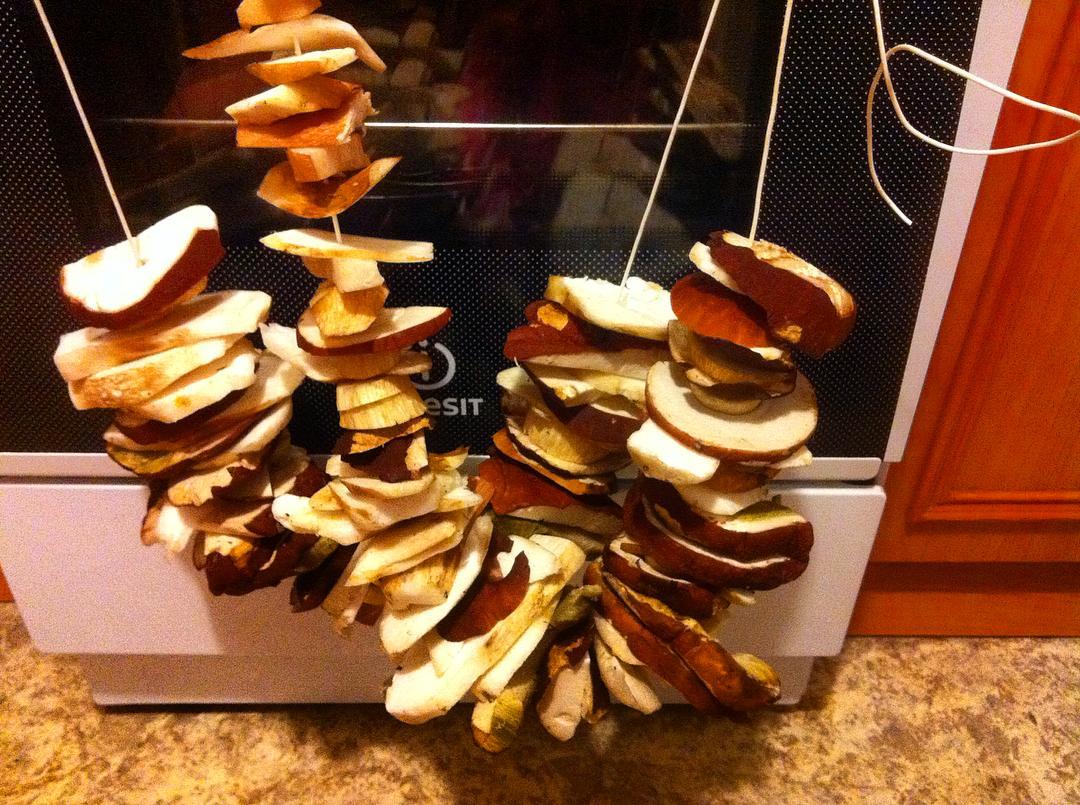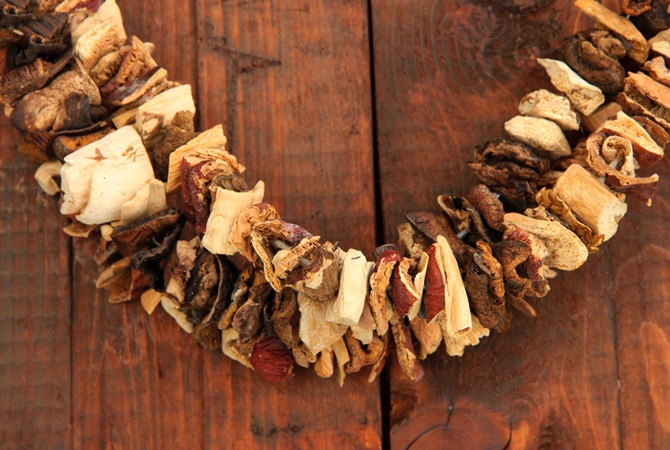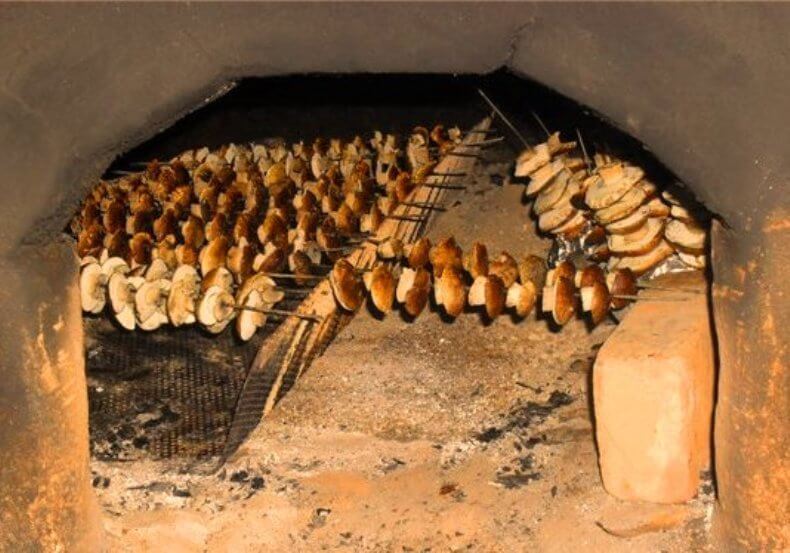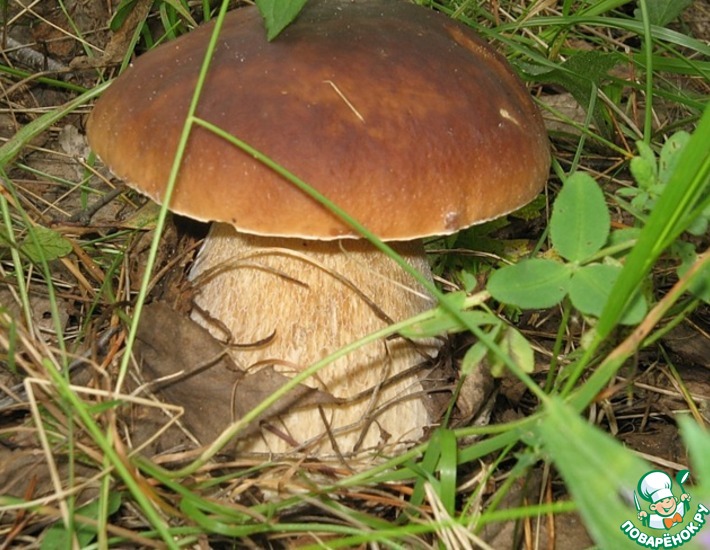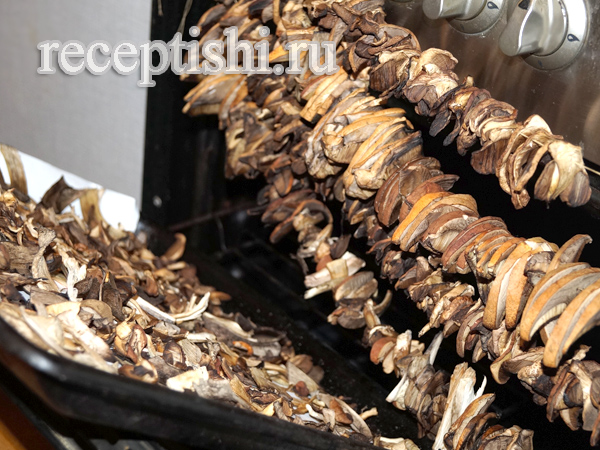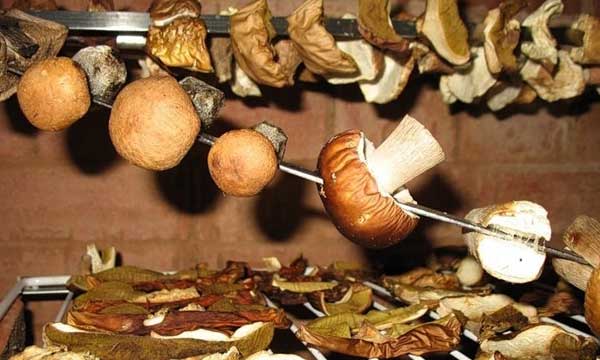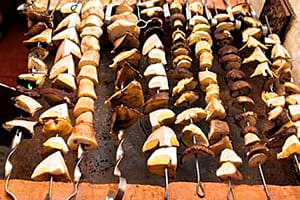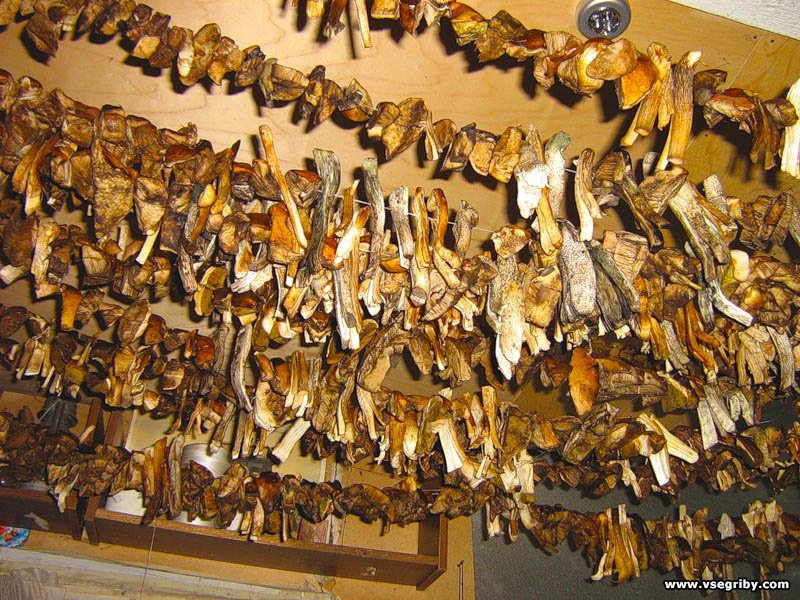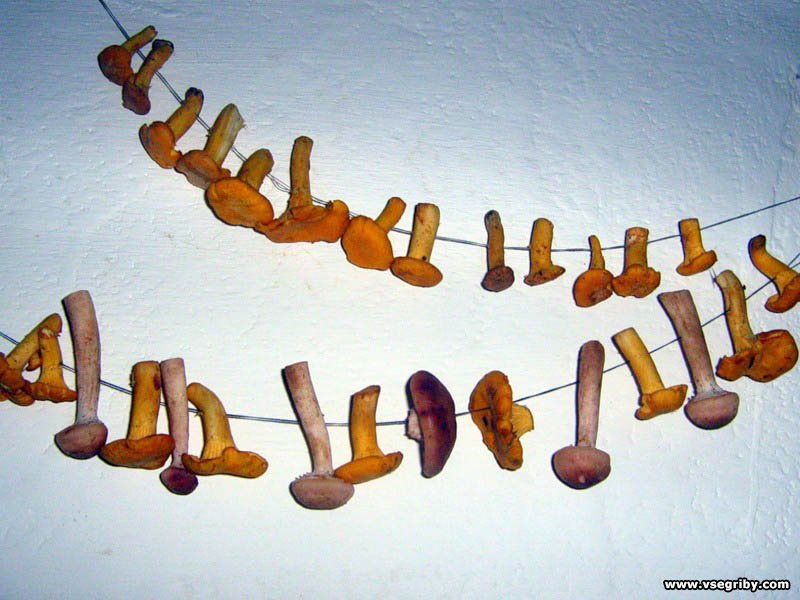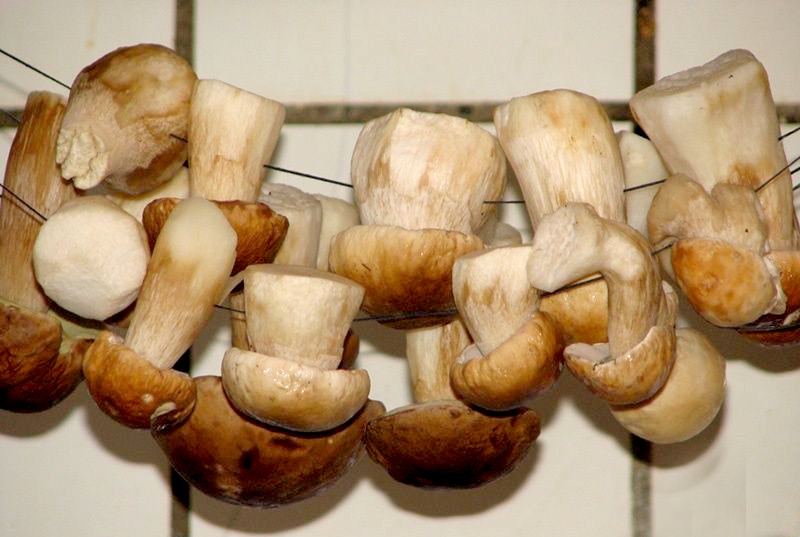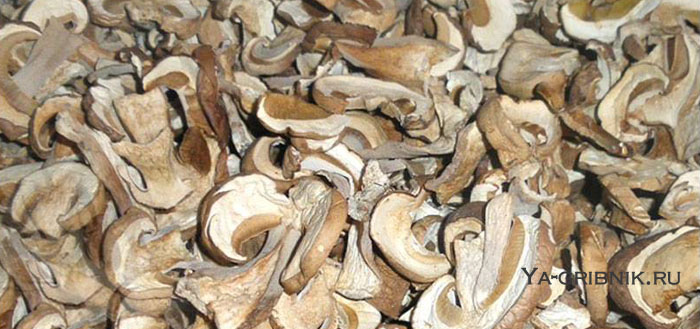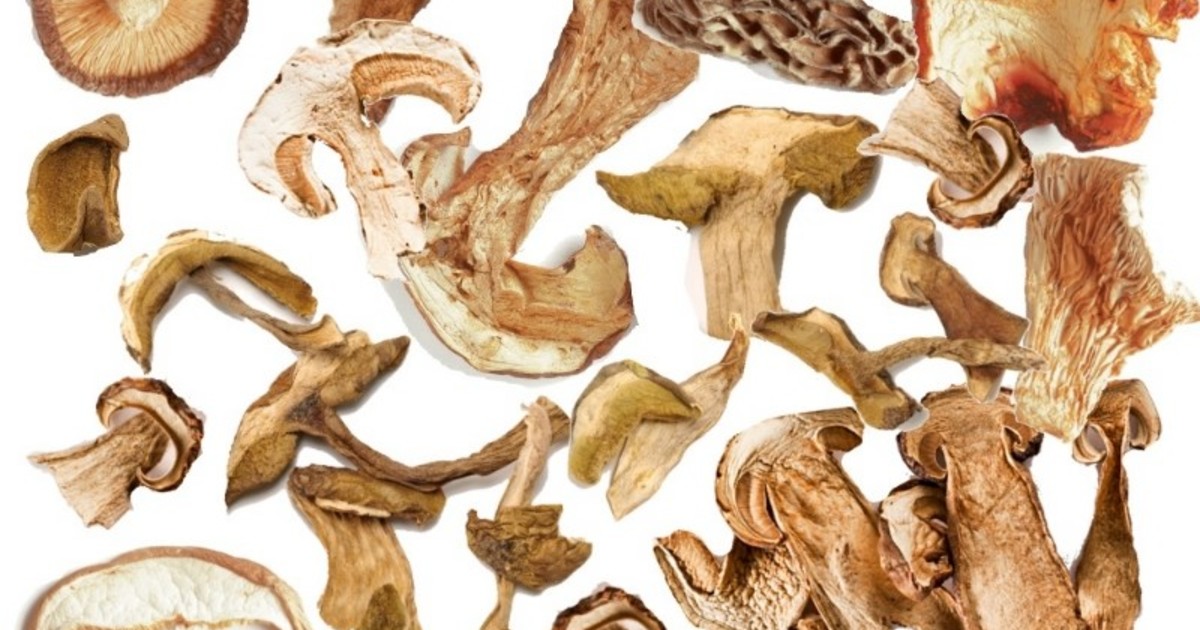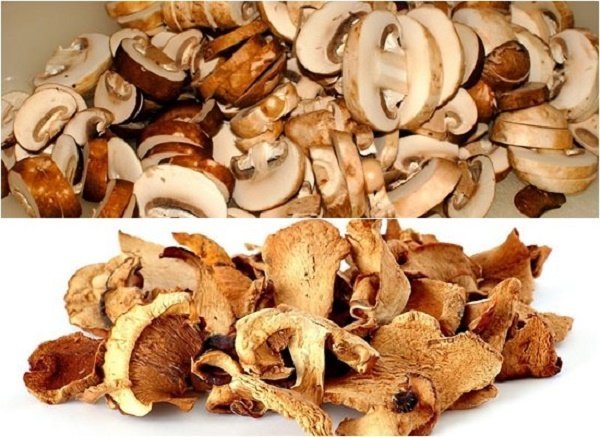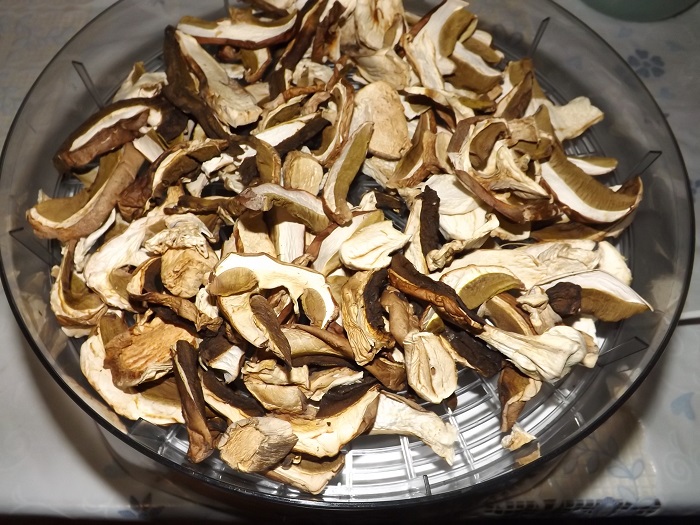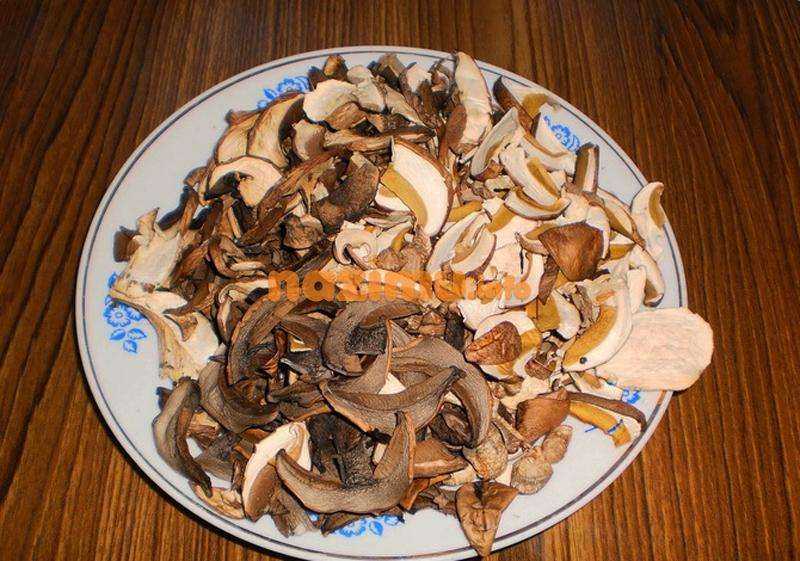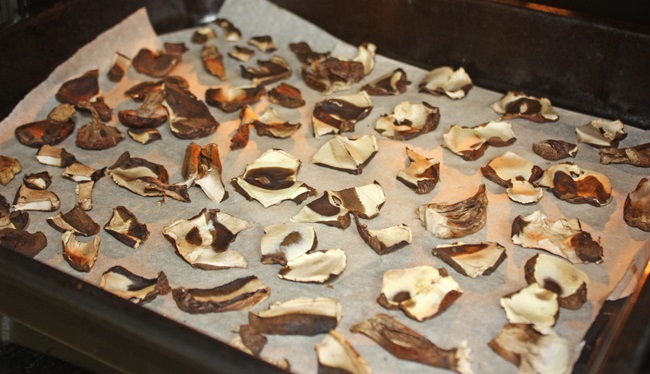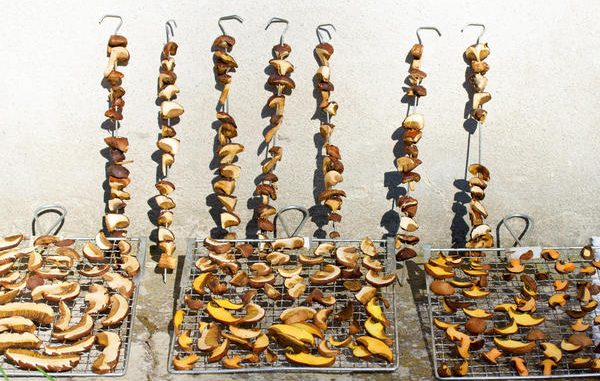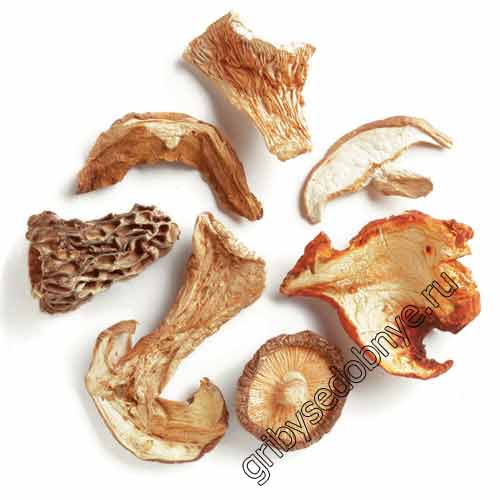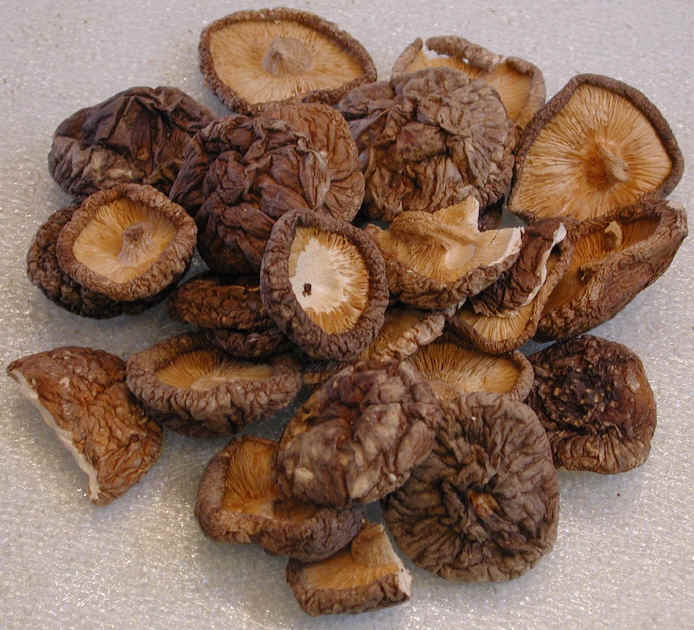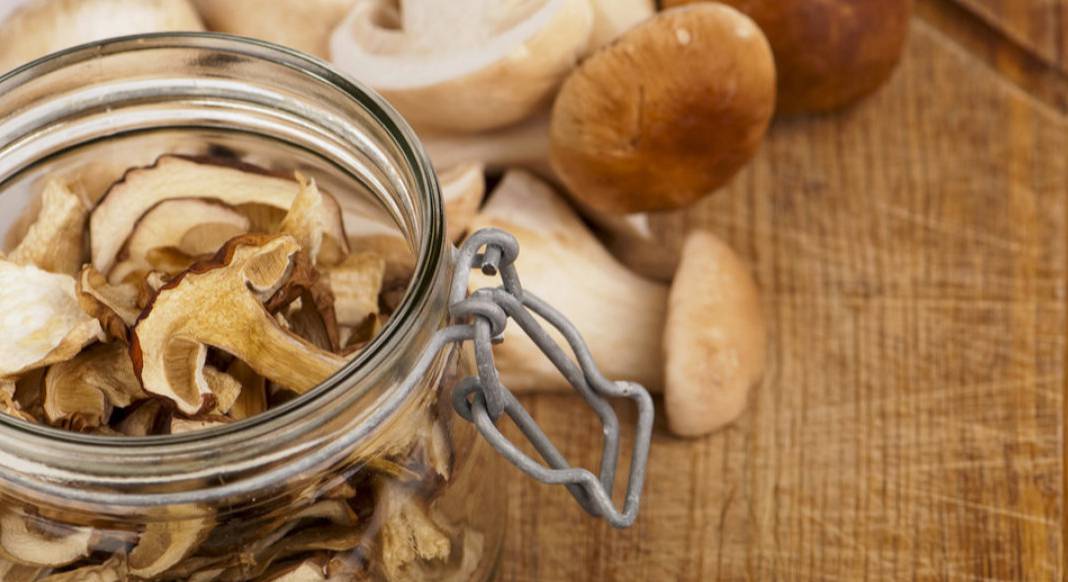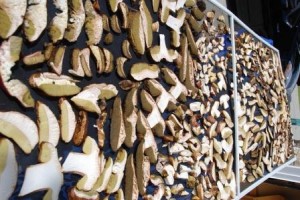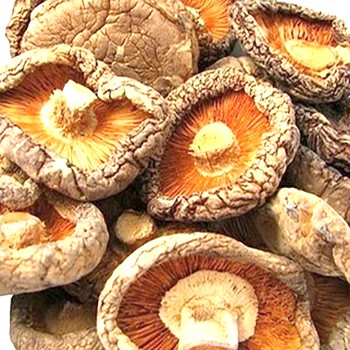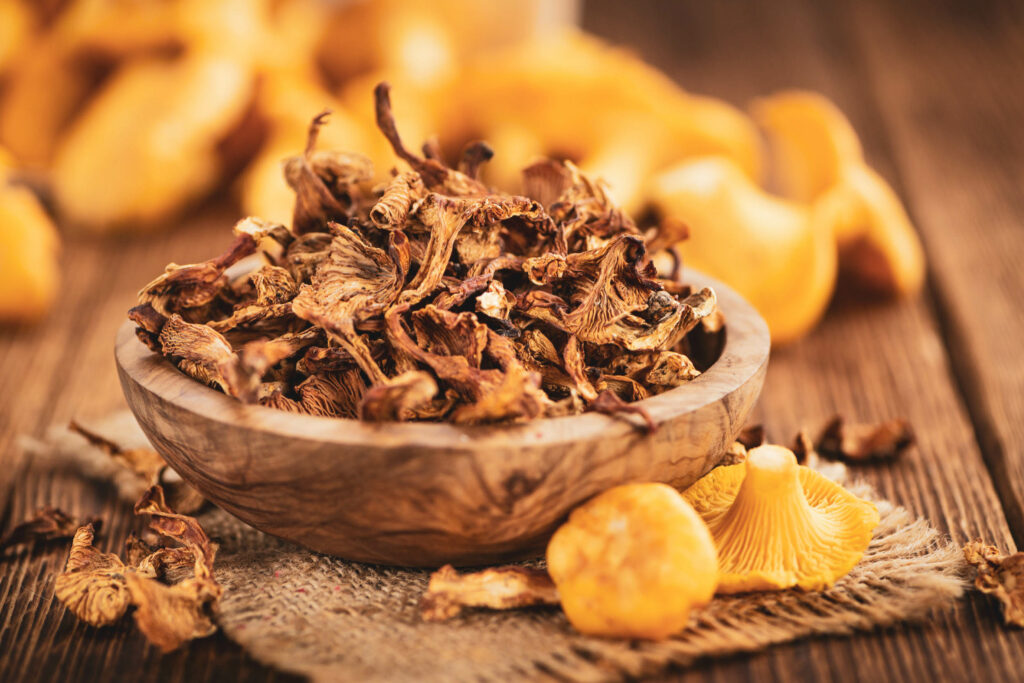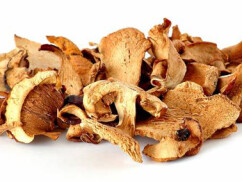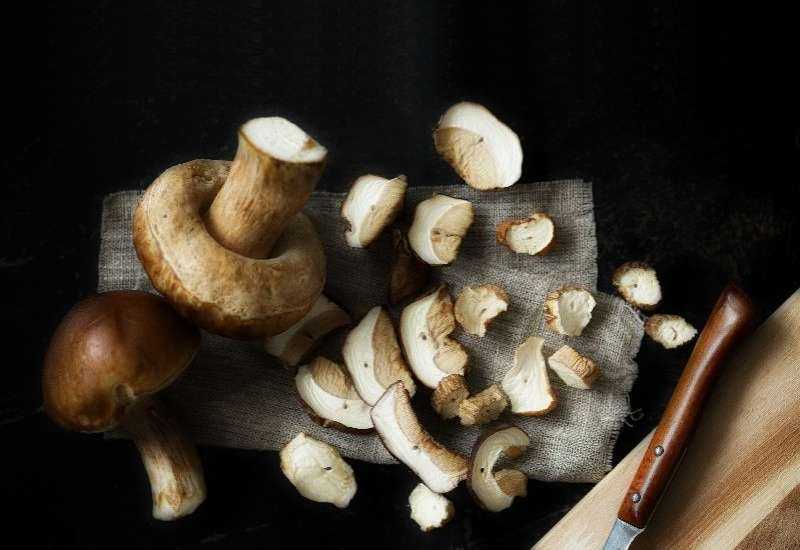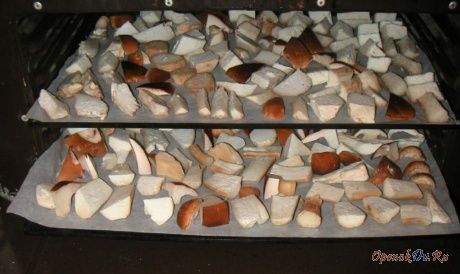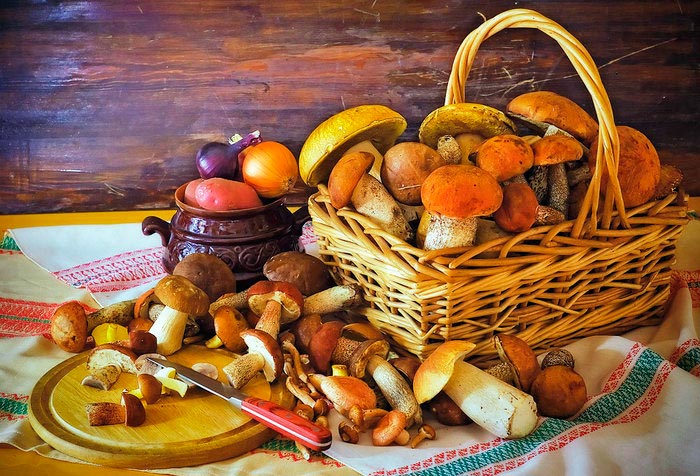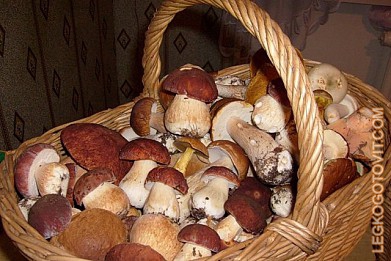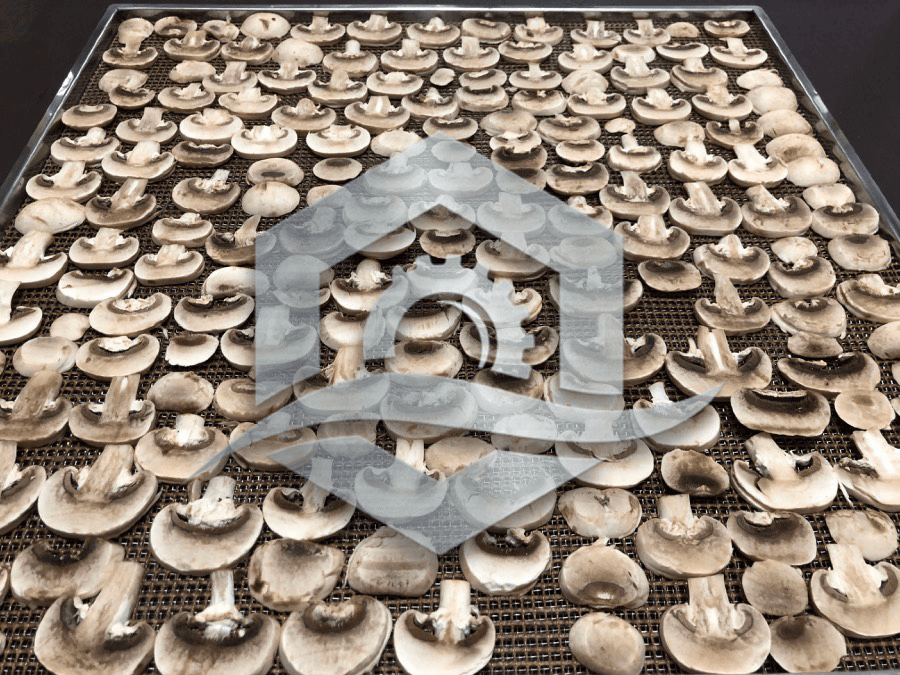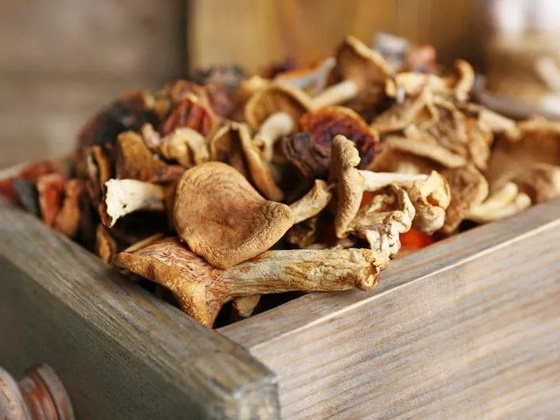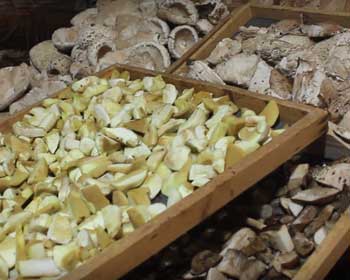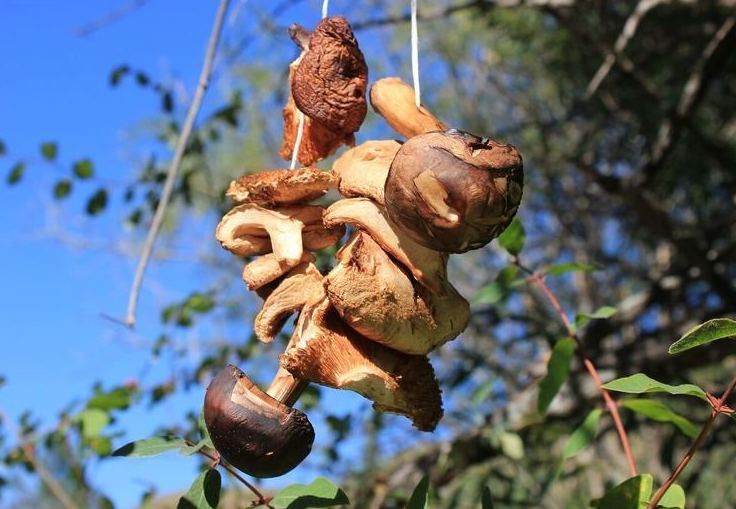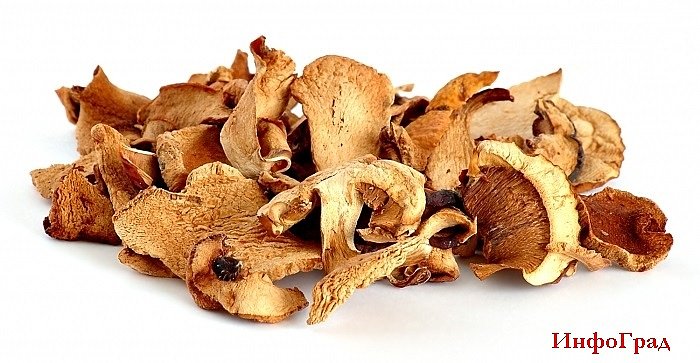How to properly store dried mushrooms
After drying, the mushrooms must be cooled and only then packed and stored. When harvested in a natural way (in the sun or on a string), by the time of drying, the mushrooms acquire an ambient temperature. All other drying options require additional time for the product to cool completely.
Storage conditions for dried mushrooms require maintaining a humid heat and light conditions. The choice of storage location depends on the packaging method.
In linen and paper containers
Dried mushrooms retain their properties very well in linen bags and paper bags. These are opaque materials that prevent the penetration of sunlight and artificial light. Additional air circulation is provided in textile packaging, so fungi will not grow moldy. The paper container also protects from the same trouble due to its hygroscopicity.
Both the bag and the package must be securely closed so that air does not get inside the package, insects cannot get through, and dust does not accumulate. If the package cannot be tightly closed after opening, then the mushrooms should be packed in small portions, so that each will be enough to prepare a particular dish.
In vacuum bags and containers
Storing dried mushrooms under vacuum is a good modern solution. This environment removes bacteria that can lead to mold and rot. In order for the mushrooms to retain their qualities in a bag or container with a vacuum valve, it is better to store them in a cool place, you can even in the refrigerator on the shelf farthest from the freezer.
In glass containers
Glass jars reliably protect the workpieces from moisture and odor absorption, insect attacks and other hazards that can spoil dried mushrooms. With all its advantages, such a container allows light to pass through, which can lead to overdrying of mushrooms and their destruction.
Therefore, it is better to use a container made of colored tinted glass, and if there is none, store the workpieces in dark places where light does not penetrate. Before packing, the jars are sterilized, and after filling with dry mushrooms, they are tightly sealed.
For any storage method, it is recommended to eat all dried mushrooms for the current calendar year. And with the onset of the new season, start fresh preparations.
Variety selection
Choose large or medium sized apples with thin skin and a small seed box. This choice results in less waste and more raw materials.
When choosing apples for drying, first of all, pay attention to the autumn varieties of sweet and sour taste. Not only taste, but also a large amount of dry matter distinguishes these apples from others.
Sweet apples very often, after drying, do not have a pronounced taste, which many may not like.
The best varieties for drying are Antonovka, Pepin, Aport. I tried to dry Sinap Orlovsky, but was disappointed with the taste. Probably because it is a winter variety, and it is worth taking a good quality carrion for drying, if you really want to dry winter varieties.
Summer apples with sourness
But this is not the only secret! The main thing is to properly prepare the apples.
Storage conditions and shelf life at home
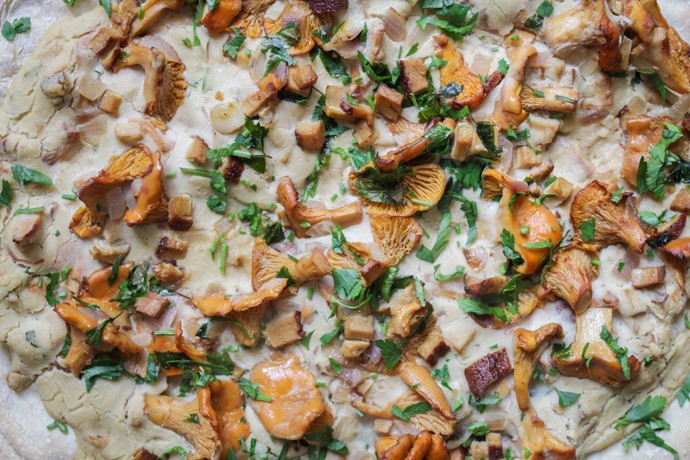
Some mushroom pickers grind the chanterelles into powder (using a coffee grinder), and then add them to various culinary dishes. The powder is poured into a ceramic or glass container (pot, jug, large jar) and closed with a lid. It is necessary to store raw materials in a dark and dry place.
The shelf life of chanterelles in cotton bags is 2-3 years, in ceramic or glass containers - about 1 year (because.air does not penetrate, but the mushroom aroma is better preserved). In wooden and tin containers, the shelf life is approximately the same as in glass and ceramic dishes.
How to properly dry mushrooms at home - oven drying and other methods
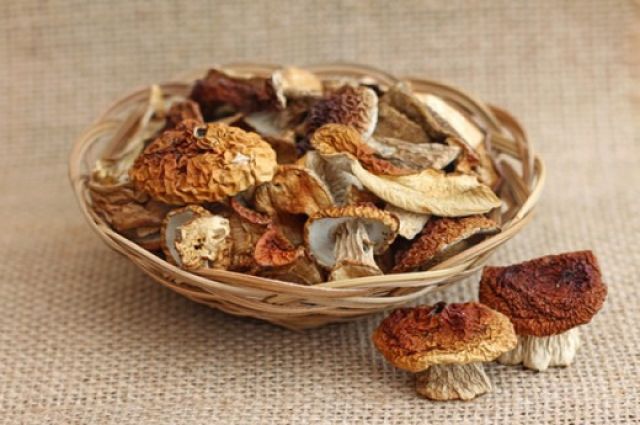
Drying is one of the best ways to harvest mushrooms. It increases their shelf life and endows them with special properties that are revealed during cooking. Soups, salads and main courses are made more aromatic and tasty from dried mushrooms.
This method of harvesting allows you to preserve all the valuable and nutrients and it is preferable from the point of view of health. The dried product is easier for the stomach to digest and does not cause botulism
And last but not least, dry mushrooms take up little space.
Drying mushrooms at home begins with the analysis of prey brought from a quiet hunt. Not all types can be dried. Tubular and marsupial representatives - boletus, boletus, boletus, boletus, moss, chanterelles, morels and honey agarics can be dried. But lamellar - milk mushrooms, volnushki and greenfinches are usually soaked before cooking, which means they cannot be dried.
Some edible mushrooms without processing can cause severe poisoning, such as milk mushrooms. Bitterness is removed from them by soaking, which is dangerous to health.
It is customary to harvest boletus mushrooms this way, because in the process of drying they acquire an unsurpassed taste. In terms of nutritional value, they can be compared to meat. They are dried on a thread, choosing healthy, beautiful and strong specimens for them. The leg is cut off, leaving a small part for the strength of the cap. You should not throw it away: cut it into circles, put it on a thread. If it is thin, then you can divide it along.
Drying of porcini mushrooms is carried out outside during the hot season. They are hung in a ventilated place, but contact with direct sunlight should be avoided.
Mushrooms at home can be spread out on a tray, cloth cutter, or dry board. The only condition is that they need to be stirred. After 3-4 days, maximum a week, they will be ready.
After cutting the collected prey into plates, spread it on a baking sheet covered with parchment and send it to the oven, heated to 45 ⁰С. When the product withers a little and begins to stick to the paper, the temperature should be increased to 70⁰С.
It is important to leave the cabinet door ajar so that air can circulate freely. The process will take at least 2 days, during which they must be removed from the cabinet for mixing, airing and cooling.
This way you will preserve the beautiful color of the white mushroom pulp, without overdrying the product and preventing possible burning.
The process will take at least 2 days, during which they must be removed from the cabinet for mixing, airing and cooling. This way you will preserve the beautiful color of the white mushroom pulp, without overdrying the product and preventing possible burning.
The previous method is not without its drawbacks. In the warm season, heating an apartment with a slightly open oven for two days is not entirely comfortable for its residents. And not everyone has ovens that can maintain a low temperature.
All you need to do is arrange the chanterelles, boletus or boletus mushrooms, cut into thin slices, on trays, close the lid and set the desired time or program. The product will be ready in 6-8 hours.
If you do not have an electric dryer, a microwave will help out, since this device is in every home today.
Having spread the mushrooms cut into plates on a glass tray, close the door and turn the toggle switch for 20 minutes, setting the power to 100-180 W. Drain the released liquid, cool the mushrooms, leaving the appliance door open.
You need to take one slice and try to bend it. If it gives in, does not break or crumble, then you can put it away for storage. But if it seems to you wet, with a dense structure, then you should continue drying, otherwise it will rot and mold.
It should not be too fragile and hard, because this will indicate that you have dried it out. Do not rush to throw away such mushrooms.
They can be ground into powder, covered with salt and spices and used to prepare various dishes, giving them a unique taste and aroma.
The finished mushrooms are collected in wooden boxes and wrapped in clean white paper. If you don't have enough of them, put them in a paper bag or linen bag.
Keep away from places of high humidity and check for insects. That's all the recommendations.
Following them, you can easily prepare mushrooms for the winter and throughout the cold season you will enjoy tasty and healthy dishes, delighting yourself and your family.
Drying process: preparation
The first problem that a person who wants to dry mushrooms faces is the following: it is necessary to make sure that the forest mushroom, being initially dirty, turns into a clean one. The fact is that it is undesirable to subject mushrooms to wet cleaning, because this will prolong the drying process for some time due to the fact that the product absorbs excess water. Therefore, the main method for cleaning mushrooms is an ordinary knife.
Using it, it is necessary to carefully remove the needles, fragments of leaves and plants from the cap. It is not recommended to touch the skin, because most often the mushroom is dried along with it.
The sand on the legs and caps can be removed with a soft brush, which must not be moistened. The remnants of the sand are washed off already in winter, because the dried mushroom is always soaked in water before starting to cook it.
Important! Even small mushrooms should be cut into pieces before drying, because they can harbor a variety of parasites. It often happens that a worm lives in an elastic and externally holistic vegetable.
If you plan to dry boletus, mushrooms or tubular mushrooms, then you need to cut them longitudinally, having previously separated the cap from the mushroom leg.
The boletus is cut in half with a notch across. If a worm or a whole set of different parasites is found inside, then the mushroom is forbidden to dry, despite how beautiful it looks.
It is advisable to use a plastic knife. Despite the inconvenience of handling it, just such a knife does not lead to the fact that the pulp of the mushroom is oxidized. And the oxidation of the legs or caps does a huge damage to the taste of the dried mushroom.
How to prepare mushrooms for drying
The taste of the resulting blanks depends on the quality of preparation. Therefore, this stage should be given a fairly long time and only the best specimens should be selected for drying.
It is important to pay attention to the following points:
- Before drying, the entire crop must be carefully sorted out and mushrooms, suitable for this processing, must be set aside. It is required to sort them by type (spongy separately from lamellar), choose the strongest, driest, without damage.
- It is best if the selected specimens are clean. Washed mushrooms lose some of their aroma during the drying process and may start to deteriorate (mold, worm). Therefore, it is desirable to avoid wet processing of raw materials.
- From fragments of soil, needles and other dry dirt, each mushroom must be cleaned by hand using a knife and a slightly damp cloth. The mycelium, if preserved, should be completely cut off. Rotten, wormy, very wet, old raw materials should not be partially used by removing the spoiled part or drying with a towel.
- Many types of mushrooms turn black on contact with metal. Therefore, for their processing, it is better to choose a ceramic or plastic knife, tools made of bone and horn are suitable.
- It is better to separate the spongy mushroom caps from the legs. These parts have different structures and textures, so they need to be prepared in different ways to dry.
- It is better to dry the hats whole or cut into halves or quarters. The legs can be cut both in the longitudinal direction - into sticks, and in the transverse direction - into circles.Pieces of any shape should be about 5 mm thick.
- Lamellar mushrooms are advised to be left intact. When sorting them before drying, they must be shifted very carefully so as not to damage the fragile caps.
We must be prepared for the fact that less than half of 10 kg of the crop will be suitable for drying, which in dried form will be about 1 kg. Of this amount, about a third may turn out to be unfit for human consumption if the harvesting technology is violated.
How much and how to properly dry mushrooms
Using the energy of sunlight, you need to remember that the fruits will dry well only in a dry atmosphere. Therefore, a rainy and cold summer is not the best time for this type of blanks. The weather should not be rainy. Humid air can spoil the fruit. The mushrooms are dried in the sun for about a week. They need to be strung on a thick thread or fishing line and hung with garlands so that they do not touch each other. To prevent annoying flies from spoiling the mushrooms, they can be covered with transparent gauze. This method is also used in field conditions, when excess products do not interfere at all, and there is simply no other way to store them.
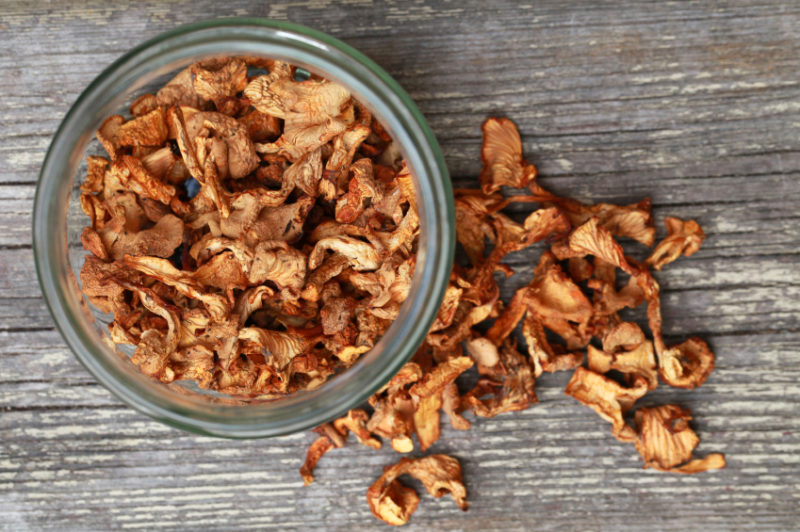
dried mushrooms
When preparing supplies at home, the most common drying tool is the oven. For the procedure, only large fruits that have not been touched by worms are required. The peeled mushrooms must be wiped with a damp cloth (they cannot be washed, because otherwise they will absorb the water that is not needed now and will dry longer). With a cloth, you need to remove dirt and adhering foreign particles: leaves, pine needles, earth, moss. The largest are cut in half. The legs can be cut into large pieces.
It is most convenient to dry mushrooms using specialized equipment: a sieve, wire rack, skewers. The finished product is dry to the touch, slightly elastic, may break when force is applied. The fruits dry out about ten times. In other words, to get a couple of kilograms of dry product, you need twenty kilograms of fresh one.
Recommended reading: When to plant onions before winter?
For uniform drying, you need to periodically monitor the process and remove ready-made fruits, leaving more space for those that have not yet dried. If the mushrooms turn out to be too dry, they will lose their aroma and taste, and the under-dried ones will grow moldy at every opportunity.
In the sun, you can dry the mushrooms before further heat treatment. To do this, you need to lay out the prepared fruits on paper or any other dry and moisture-absorbing surface, and place this surface in the sun.
It is important that the location of the mushrooms is protected from dust and water. Drying for more than two days is not recommended - otherwise they will lose their color and taste.
To dry in the oven, place the mushrooms on a baking sheet or wire rack in one layer. The temperature of the procedure should not exceed sixty degrees, and the door should be open. If the oven is equipped with an induction function, the door does not need to be opened. While the floors are drying, the trays or racks must be swapped. Mushrooms or their pieces should lie freely, not touching each other.
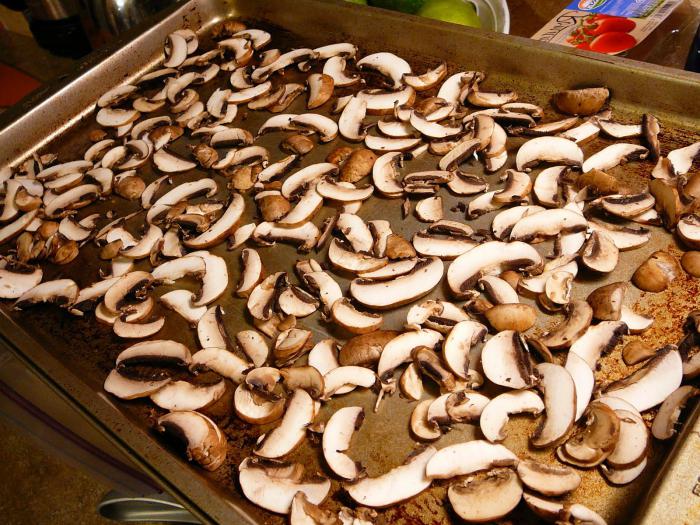
mushroom drying process
First, it is necessary to dry the fruits in the sun or at a lower temperature, for example, at forty-five degrees. If the temperature is higher, the proteins that make up the mushrooms will stand out on the surface and dry out, giving the mushrooms a dark color. In addition, the fruits become unusable due to their softness. To avoid such consequences, the temperature can be increased only after the fruits stop sticking to each other and their surface becomes dry.
The duration of the procedure depends on many factors: the type of mushrooms, the size of the pieces, the power of the oven. Periodically, you need to stir flat and remove those already ready for storage.
Drying mushrooms
Drying is one of the easiest and most affordable ways to harvest mushrooms.Dried mushrooms keep well for a long time. In terms of nutritional value and digestibility, they are superior to salted and pickled mushrooms. In terms of protein content, dried mushrooms are superior to canned ones. When dried, all the nutritional advantages of mushrooms are preserved; The aroma of some species is even enhanced with this method of preparation, as, for example, with a porcini mushroom.
However, not all edible mushrooms can be dried. Many lamellar mushrooms contain bitterness, which does not disappear during the drying process. Such mushrooms are not suitable for drying.
At home, you should dry the following types of mushrooms:
- from tubular - porcini mushrooms, aspen mushrooms, boletus mushrooms, all types of boletus, moss, goat, oak, Polish mushroom;
- from marsupials - morels, morel cap, white truffle;
- from tinder fungus - ram mushroom, variegated and branched tinder fungus;
- from lamellar - autumn mushroom, summer and winter mushroom, variegated umbrella mushroom, champignons, whiskers, fleecy scales, deer mushroom;
- from chanterelles - common chanterelle.
You can dry mushrooms outdoors (in the sun), in a Russian stove (or simply - a stove), in an oven, over a gas or electric stove, on exotic heating devices - a kerosene stove or kerosene stove, using modern microwave ovens, on central heating batteries and etc.
Air drying of mushrooms is possible only in hot dry seasons, on clear sunny days. In cloudy damp weather, it is impossible to dry mushrooms in the open air, since they can deteriorate and they have nothing to dry with. Natural drying of mushrooms in the sun takes about a week. Mushrooms are strung on strong, harsh threads, thin twine or fishing line and hung in sunny places so that they do not touch. You can make special stands for this, place mushrooms strung on threads or metal rods on them and put them in the sun, covering them with gauze from dust and flies.
The most reliable methods should be considered drying in a Russian oven, drying mushrooms in an oven or over a stove (gas or electric).
For drying, select fresh, strong, healthy mushrooms, not damaged by worms.
The peeled mushrooms are wiped with a clean, slightly moistened soft cloth (preferably nylon), clearing them of needles, leaves, moss, sand, earth and sorted by size. Large caps of mushrooms, to speed up the drying process, are best cut into slices, cutting off the stem at a distance from the cap. Legs of porcini mushrooms, boletus and boletus are cut into columns up to 2 cm long or with wheels up to 2 cm thick. In butter mushrooms, mushrooms, honey agarics and chanterelles, only caps are used for drying, and morels and lines are dried whole. Mushrooms must not be washed before drying, as they absorb a lot of water, dry out very slowly and can deteriorate.
To avoid contamination, it is better to dry the mushrooms on special devices: sieves, grates, braids strung on a thread or on pins installed on wooden racks or on the needles of a mushroom dryer.
Mushrooms are considered dried if they feel dry, light to the touch, bend slightly, or break with some effort. Well-dried mushrooms have a taste and aroma reminiscent of fresh ones. The "yield" of dry mushrooms is on average 10-14% to the mass of raw peeled. Thus, from 10 kg of fresh mushrooms, only dried ones are obtained.
Dried mushrooms, and first of all, small caps dry out, you need to periodically clean up in a timely manner, and dry the remaining ones to the desired condition. Do not overdry mushrooms, as they become tasteless and lose their aroma, do not soften and do not boil during cooking. At the same time, under-dried mushrooms are poorly stored, begin to grow moldy at the slightest dampness and quickly deteriorate.
All tubular and lamellar mushrooms and tinder fungi can be dried in the Russian oven. It is impossible to dry from the wrinkle in the oven.
How to dry mushrooms
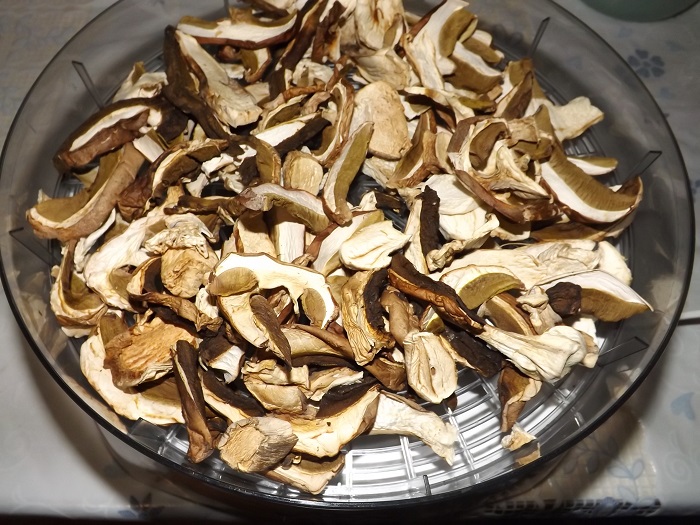
Posted by Irina Osipova | in the category Blanks, Recipes tasty and inexpensive, Drying 09/24/2014
Mushrooms are a very tasty product on our table, with them our daily diet becomes much more extensive and varied.
Already fried with potatoes, and overeat with soup ... To enjoy delicious mushrooms all year round - frozen, pickled and salted.
It remains to dry, well, at least a little. After all, in winter dry mushrooms are an excellent replacement for fresh ones, and they are not the last place in the lean menu.
There are several ways to dry mushrooms - in the open air (on dry, sunny days), in special dryers (there are already such kitchen gadgets), over a gas stove or just in the oven - this is a simple and convenient way for home conditions I will share.
It is rather difficult to indicate the number of servings and ingredients, as well as the cooking time in this recipe - it all depends on how many mushrooms you managed to collect and how many of them you decided to use for drying.
Total cooking time - 6 hours 0 minutes Active cooking time - 2 hours 0 minutes Cost - very economical Calorie content per 100 g - 282 kcal Number of servings - 50 servings
Ingredients:
Mushrooms - optional, any fresh, forest
Preparation:
Mushrooms must be just picked (fresh), strong and not wormy - for this they must be carefully sorted out, cleaned of forest debris (moss, pine needles, leaves, sand).
It is not recommended to wash the mushrooms for drying - this way they will absorb excess water, and because of this, the drying time will increase, and the mushrooms may darken. It will be enough just to wipe the mushrooms with a damp sponge over heavily soiled areas.
Further, the mushrooms must be sorted by size - cut large caps into slices; legs, if thick - round, if not very - then just columns will be enough. The slices are about half a centimeter thick.
Arrange the prepared mushroom slices on baking sheets covered with baking paper. They should be laid out in one layer so that they do not come into contact with each other.
Put the baking sheets in an oven heated to 50 degrees for 1 hour with the door ajar (for better air circulation). In general, it is advised to start at 45 degrees, but, for example, in my oven, the minimum heating is set exactly at 50. During this time, the mushrooms will dry up a little and cease to be sticky.
Then you can increase the temperature to 75-80 degrees and leave to dry further, with the door still open.
Already dried mushrooms should be removed for storage, and the rest, turned over, sent for drying.
A properly dried mushroom should be firm, elastic and slightly bend, not crumble or break. An unfinished mushroom is still soft, as if rubbery.
You can store whole dried mushrooms in glass or metal, tight-fitting jars; linen bags or paper bags.
Well, the mushrooms themselves should be periodically checked so that they do not get damp in any way. In this case, they must be sorted out without delay, the spoiled ones should be removed (if any) and dried again.
By the way, dried mushrooms can be frozen, so they will last longer.
Before cooking, dried mushrooms must be soaked in cold water for 1-2 hours. Do not pour out the water in which they were soaked - this is a wonderful mushroom broth!
Well, in the event that your mushrooms are dry, become too brittle, then you can make mushroom powder from them. It can be added to any dishes (sauces, gravies, soups ...) for a richer and richer taste, because mushroom powder fully preserves the taste and aroma of mushrooms.
To this mushroom powder, if desired, you can add spices - salt, pepper, nutmeg - a smart substitute for store-bought bouillon cubes!
It is also necessary to store mushroom powder away from dampness and sunlight, in hermetically sealed containers.
You might like these recipes?
How to prepare mushrooms for drying
I want to draw your attention to the fact that mushrooms are NEVER WASHED before drying.
This is very important, because mushrooms are saturated with moisture from contact with water and subsequently take too long to cook.
How to clean the mushrooms from dirt and dust? Many experienced mushroom pickers advise doing this very gently with a slightly damp sponge. Other mushroom experts believe that it is best not to moisturize mushrooms at all. We usually use a sharp knife and a brush or sponge to shake off any dirt or sticky needles.
Mushrooms can be dried whole or cut into several pieces. In the first case, the drying process will take longer. If you decide to cut mushrooms, try to do so so that you get neat pieces of about the same size. Mushrooms, cut into pieces, must be dried immediately, otherwise they will become chapped and the quality of the product will decrease.
And now is the time to choose a suitable method of drying mushrooms that you can use at home.

Rules and shelf life of dry boletus
It is easy to determine the readiness of the mushrooms - the dried boletus is elastic in moderation, it bends hard, but at the same time it is not covered with cracks. A poorly dried mushroom is overly soft - it will grow moldy during storage, while overdried, on the contrary, is fragile and breaks easily.
It does not matter if, out of inexperience, you have overdried the boletus mushrooms - you can make a fragrant seasoning from them by chopping with a blender and adding salt.
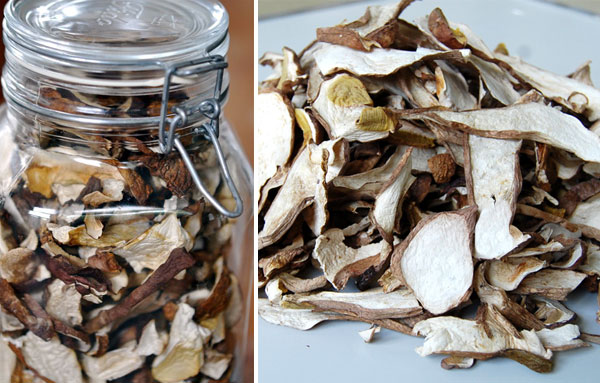
Dried porcini mushrooms are stored wrapped in clean paper and placed in wooden boxes. If their number is small, then you can simply pour them into a paper or linen bag. You can also leave them hanging on the line.
Freshly dried boletus is sometimes placed in sterilized glass jars, which are hermetically sealed to prevent the mushrooms from spoiling. To do this, the edges of the jar are greased with alcohol or water, set on fire and immediately tightened with a lid. Due to these manipulations, a small vacuum is created in the bank. The shelf life of dried boletus is from 12 to 18 months.
The place where dried boletus is stored must be dry, free of foreign odors, well ventilated. You can put a salt shaker near the fruit bodies - the salt will absorb excess moisture
It is also important to periodically check the condition of the fungi - whether there are insects, whether they are moldy or damp. In the latter case, they can be dried in any way described above.
By the way, during drying, mushrooms lose a lot in mass - from 10 kg of fresh, only 1.5 kg of workpiece will turn out. Dried whites should smell like fresh ones. They should be soaked in water before further use, unless they are used to make mushroom powder.
The skill in drying porcini mushrooms will only come with experience, do not worry if the first batches are spoiled. Choose from the methods described above which is the most suitable for you.


